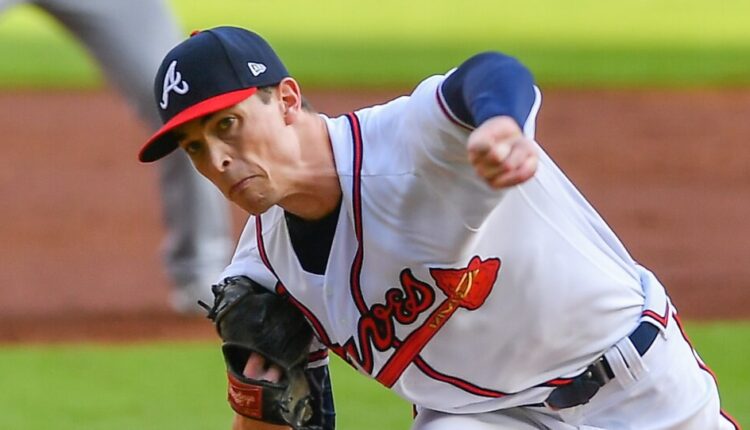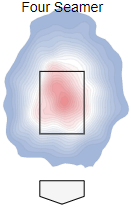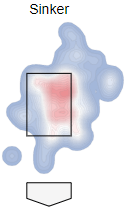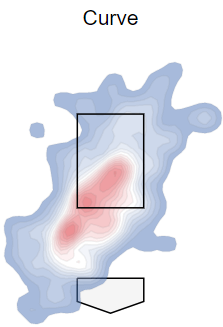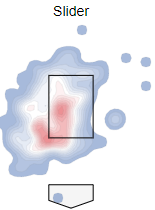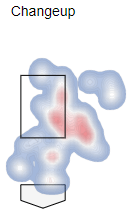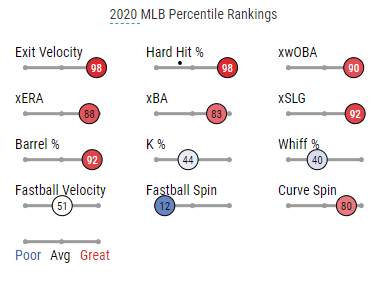Max Fried is an excellent pitcher, and he enjoyed himself quite the shortened 2020 season. In 56.0 innings pitches, Fried had a 2.25 ERA, a 1.09 WHIP, and 50 strikeouts. He showed a deceptive fastball that he could reach back and hit 96-mph regularly with. A hammer curveball that gets 90percentile drop. And a revamped slider that horizontally moves the length of a standard ruler.
On the downside, Fried’s ability to stay healthy once again came into question following another injury in the 2020 season. In this article, Fried will be broken down and examined for what he does right, wrong, and everything in between. This will all lead to his outlook for 2021 and beyond.
What?! Your league isn’t using Fantrax? Inconceivable! Check out everything Fantrax has to offer, and I’m sure you’ll come around to our way of thinking.
Max Fried Pitch Arsenal
Max Fried has some of the best pure stuff in all of baseball. He is a hard-throwing left-handed pitcher, who was a top ten overall pick of the San Diego Padres back in 2012. He was then traded to the Atlanta Braves in 2014. The Braves gave up Justin Upton to get Fried as their primary return. Upton was a borderline elite hitter at that time, as the Braves loved what they saw in Fried. What they saw was a potential frontline starter, and it looks like they were right.
Coming up in high school, Fried was compared to Clayton Kershaw, primarily because of his massive curveball. However, prior to being called up by the Braves in 2018, Fried’s scouting report looked nothing like Kershaw. He was the organization’s 8th-ranked prospect according to MLB Pipeline, with a 60-grade fastball, a 60-grade curveball, a 50-grade changeup, and a 45-grade control. The low control grade was due to Fried really struggling with command for a few seasons following his Tommy John surgery in 2014. With that said, his pitch grades look rather accurate, with his curveball perhaps being even better than the plus grade he received. Let’s dive into Fried’s arsenal, and examine each of his five pitches.
Four-Seam Fastball (42.0% usage in 2020)
Fried’s four-seam fastball averaged 93.1-mph on the season, down slightly from his 2019 average. While that doesn’t sound spectacular, he is more than capable of reaching back and hitting 95 to 96-mph when necessary. Also of note, Fried is left-handed, and not many left-handed starters are averaging that type if velocity on their fastballs.
The Braves ace made noticeable location changes with his fastball and enjoyed a lot of success with the pitch because of it. In 2019, Fried was over the heart of the plate too often, as evidenced by the below contour. As a result, Fried gave up 12 home runs, a .316 batting average against, and a .363 xwOBA. Not ideal results.
In 2020, Fried was more precise with his location. He consistently pitched up-and-in to righties, and away from lefties. The results were drastic, as Fried only gave up one home run with the pitch, maintained a .198 batting average against, and a .280 xwOBA. His swinging strike percentage also rose from 9.9% in 2019, to 10.8% in 2020. That is a solid number on a pitch that typically doesn’t miss a lot of bats for pitchers.
Sinker (9.9% usage in 2020)
Although it is technically a two-seam fastball, Baseball Savant uses the Sinker designation for this pitch. Regardless of the title, Fried’s sinker is a groundball machine. On the season, Fried has a 70.0% groundball rate with the pitch, and hitters averaged a -12-degree launch angle when in play. He gets a decent amount of movement on the pitch, as the 22.8-inches of drop is 1.2-inches more on average than sinker’s of similar velocity. He typically uses the pitch to run in on left-handed hitters, which is ideal against the same-handed opposition.
It was his worst pitch in terms of results in 2020, but that is the case for almost all pitchers who throw sinkers. Hitters had a .273 batting average against with a .324 xwOBA. Relatively speaking, these are still excellent results. Factor in the groundball rate Fried induces, and his sinker was an excellent last resort pitch.
Curveball (22.5% usage in 2020)
This is the bread and butter pitch for Fried. His curveball is one of the most dominant (and aesthetically pleasing) pitches in all of baseball. As his main secondary offering, the pitch is a true movement masterpiece. Fried’s 67.6-inches of drop put him firmly in the top 10 among starting pitchers in downward movement. Fried does an excellent job at keeping this pitch down, and hitters often find themselves putting the pitch into the ground when put in play.
Results-wise, the pitch is every bit as good as it looks. While he doesn’t get as much swing and miss with the curveball as one would think, hitters can’t seem to do much with it when they make contact. Fried had a 31.2% Whiff rate and an 11.9% swinging strike rate with the pitch. Both numbers actually being below average. However, that doesn’t matter when opposing batters hit .175, with a minuscule .227 xwOBA. Fried maintained a 61.5% groundball rate with the pitch, greatly minimizing any damage done when the pitch was put in play.
Slider (20.7% usage in 2020)
Another statcast darling, Fried’s slider is actually a pitch he just introduced in 2019. It is directly correlated to his success on the mound. In the below chart, you can see that as his slider usage goes up, his ERA by start typically goes down (the greater the distance between the two lines, the better).
Since Fried started throwing his slider in the 2019 season, he has been a different pitcher. Thrown nearly as much as his curveball, Fried has really found something with the pitch. It gets 39-inches of drop, which is well above average relative to sliders thrown at similar velocities. More importantly, it gets an insane 12.2 inches of horizontal break. Only five starting pitchers got more break on their sliders in 2020. His location of the slider is very interesting, as he typically will throw it up or down (as can be seen by the above video). It deceives hitters when thrown up, as their initial reaction is fastball. Fried will typically use this is a pitch that runs away from left-handed opposition, so throwing up isn’t nearly as dangerous.
When it comes to on-field results, his slider was hit slightly harder than his curveball, but it missed more bats. With a 16.7% swinging strike rate, this is Fried’s one true swing and miss pitch. The .239 batting average against was good, but he was actually unlucky with that number, as he had a .195 expected batting average against. He only gave up four extra base hits with the pitch, and allowed no home runs. Watch for Fried to continue to increase his slider usage going forward, if he does, success is sure to come.
Changeup (4.9% usage in 2020)
Not much time will be spent on Fried’s changeup, as it is purely a show me pitch only being thrown 4.9% of the time in 2020. Like his other offerings, his changeup gets a lot of downward action. With 34-inches of drop, Fried’s 83.1-mph changeup gets 1.1 inches more drop than changeups of similar velocity. Also like his other offerings, Fried has an excellent 52% groundball rate with the pitch since the beginning of the 2019 season. He strictly uses this pitch to run away from right-handed batters.
While the pitch was very bad in 2019, he actually enjoyed more success with it in 2020. He lowered his batting average against down to .200, his xwOBA to .187, and maintained an impressive 73.3-mph average exit velocity. If Fried enjoys that kind of success, he should continue upping his changeup total, while lowering his fastball usage.
Batted Ball Profile: The Soft Contact King
Looking at 2020 contact profiles on Fangraphs, Max Fried was an outlier in his batted ball profile. The first thing to not is his soft contact rate of 27.2%, it trailed only Kenta Maeda among all pitchers in the shortened 2020 season. Those two players were the only two starting pitchers to have a higher soft contact than hard contact rate.
Switching over to Baseball Savant tells more of the same story on Fried’s dominant 2020 season. In terms of average exit velocity against, Fried’s 83.4-mph ranked him first overall among qualified starting pitchers. More impressively, on flyballs and linedrives (FBLD), Fried also ranked first amongst his starting pitcher peers, with an 88.3-mph exit velocity against. His 3.3% barrel rate against was also a elite number.
If that soft contact data wasn’t mouth-watering enough, Fried was once again a heavy groundball pitcher. Over the past two seasons, Fried has maintained a groundball rate of 53.1%. That number ranks him in the top 10 amongst all starting pitchers in that time span. To sum that up, when Max Fried pitches, you can expect a lot of soft infield groundballs throughout the game. That is exactly what we are looking for in an SP1.
As far as swing and miss, Fried has been solid, especially for a heavy groundball pitcher. From the standpoint of strikeout-plus-groundball percentage (K+GB%), Fried has been over the 75% threshold that puts a pitcher in elite territory. Below are the pitchers above a 75% K+GB% rate over the past two seasons. This list of 21 pitchers arguably control their outcomes as much as any pitchers in the game under this metric.
The noticeable number there is his 24.0% strikeout rate. While that is above the league average of 22.0%, Fried had a noticeable dip in strikeouts from 2019 to 2020. In 2019, Fried’s strikeout rate was a strong 24.6%. In 2020, he was down to a Mike Soroka level of 22.3%. While this was in a smaller sample size, Soroka is often criticized for not striking out enough batters, plummeting his draft stock. So why should Fried get a pass? Fried’s swinging strike rate over the past two seasons is 11.4%, up 0.8% from the league average 10.6%. Soroka’s 10.3%, nearly right at league average. It will be interesting to see how savvy fantasy players are about Fried’s slightly above average swing and miss profile.
The Downside: Injuries and Longevity
There are some obvious concerns about Fried, and the primary concern is can he stay healthy for an entire season? While this often isn’t the case for many pitchers, Fried still has never topped 165.2 innings in a season. His injury history while he’s been in the majors is cause for at least a little concern:
COURTESY OF FOXSPORTS.
He’s been on the injured list every year he’s pitched in the MLB. In 2018 and 2019, it was a blister issue that arose around the same time each year. This is an issue that comes up from the way he grips his curveball with his pinky. Luckily in 2020, this never reared its ugly head. However, he did hit the injured list in 2020 with left-side muscle spasms. He was on the list for a short time, but nevertheless, it is still a injured list stint. Another concern with him is how far into games he pitches. Fried is ranked 120th out of 203 pitchers over the past two seasons in pitches thrown per game started (Pitch/GS).
The good news here is the fact that he is actually above average in innings pitched per game started (IP/GS). This shows that Fried is getting outs quickly, but the Braves simply don’t pitch him deep enough in games to consistently qualify for quality starts. This limits his strikeout upside even further as well. Three seasons into his MLB career, it does not appear that Fried is an option to join the elite tier of pitchers who do pitch six to eight innings every start when they are performing.
2021 Outlook
Between his elite contact profile, his ability to miss enough bats, possessing an elite arsenal, and getting his control much better under wraps, Max Fried is on the cusp of breaking into SP1 territory. His walk percentage did rise in 2020, up to 8.5% over those eleven starts. However, his 2019 total of 6.7% was a full percentage below league average. Going back to his scouting profile, Fried looks set to shatter that 45-grade control he was given. Despite concerns on the injury front, there is little logic in doubting his overall abilities. Fried is a healthy season away from giving you your top-10 overall SP numbers. If you aren’t drafting the Atlanta Braves ace early, be prepared to miss out on what could be an elite pitcher for years to come.
The regular season just got over but we are already preparing for next year. Keep track of all our 2020-21 MLB Offseason Analysis.
Fantrax was one of the fastest-growing fantasy sites of 2018/2019 and we’re not slowing down in 2020! With multi-team trades, designated commissioner/league managers, and drag/drop easy click methods, Fantrax is sure to excite the serious fantasy sports fan – sign up now for a free year at Fantrax.com.

